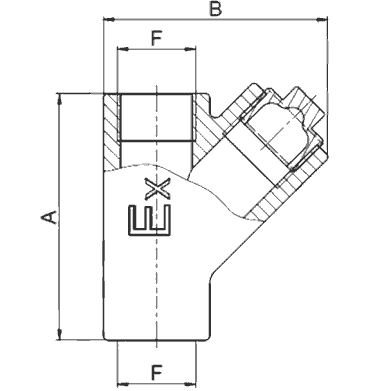Partition fittings with encapsulation with PG-COMPOUND are applied in electrical conduit for the arrangement of partition seals of separate sections during installation in electrical conduit and carrying out local leakage tests in the electrical conduit.
Separation of sections of the electrical conduit using fittings with encapsulation with PG-COMPOUND ensures prevention of ingress of combustible gases, vapors or flame from one part of Exd conduit section to another.
Partition fitting encapsulated with compound shall be installed as close as possible to Exd enclosures of distribution boxes, boards, control cabinets, light fixtures. Partition fittings are used for the separation of each internal volume of a separate Exd enclosure and from the enternal space of electrical conduit.
For the provision of explosion protection, the cable shall be separated to the conductors and partition fittings shall be encapsulated with PG-COMPOUND. The fitting is filled with non-flammable glass fiber in order to prevent running out of the compound before its curing.
Partition fittings with encapsulation with PG-COMPOUND are intended for the prevention of transfer of the explosive mixture through the pipe from one room to another, for the transition between areas and also for the division and separation of the internal volumes of the explosion-proof equipment. Special function of the partition fittings is that they prevent ingress of fire to the pipes with cables.
Partition fittings prevent distribution of gas, vapors and fire in the electrical conduit.
RZV - vertical partition fitting joint
Scope of application - hazardous indoor and outdoor areas in accordance with explosion protection marking, GOST 30852.13-2002 (IEC 60079-14:1996) and areas hazardous with combustible dust ignition, as per GOST IEC 61241-3-2011, dangerous production facilities of I, II, III, IV hazard classes under supervision of Rostekhnadzor and national supervisory bodies of the CU and the CIS countries.
 1Ex db IIC Gb
1Ex db IIC Gb 1Ex e IIC Gb
1Ex e IIC Gb 2Ex nR IIC Gc
2Ex nR IIC Gc Ex tb IIIC Db
Ex tb IIIC Db Ex db IIC Gb U
Ex db IIC Gb U Ex e IIC Gb U
Ex e IIC Gb U Ex nR IIC Gc U
Ex nR IIC Gc U Ex tb IIIC Db U
Ex tb IIIC Db U РВ Ex db I Mb
РВ Ex db I Mb РП Ex e I Mc
РП Ex e I Mc Ex db I Mb U
Ex db I Mb U Ex e I Mc U
Ex e I Mc U
| Dimension type | F | Amount of compound, g | A, mm | B, mm | Mass, kg |
| RZV1G | 1/2" | 35 | 70 | 56 | 0,1 |
| RZV2G | 3/4" | 50 | 85 | 72 | 0,1 |
| RZV3G | 1" | 100 | 90 | 73,5 | 0,2 |
| RZV4G | 1 1/4" | 240 | 110 | 91,5 | 0,25 |
| RZV5G | 1 1/2" | 240 | 109,5 | 91,5 | 0,3 |
| RZV6G | 2" | 380 | 129 | 110 | 0,4 |
| RZV7G | 2 1/2" | 1250 | 162 | 135,5 | 0,5 |
| RZV8G | 3" | 1350 | 175 | 149 | 0,8 |
| RZV10G | 4" | 1450 | 185 | 175,5 | 1,1 |
| RZV | X | / | Х | – TU 3400-007-72453807-07 | |
| Type of element | |||||
| Dimension type | |||||
| Options, accessories and versions |
EXAMPLE: RZV8R-TU 3400-007-72453807-07